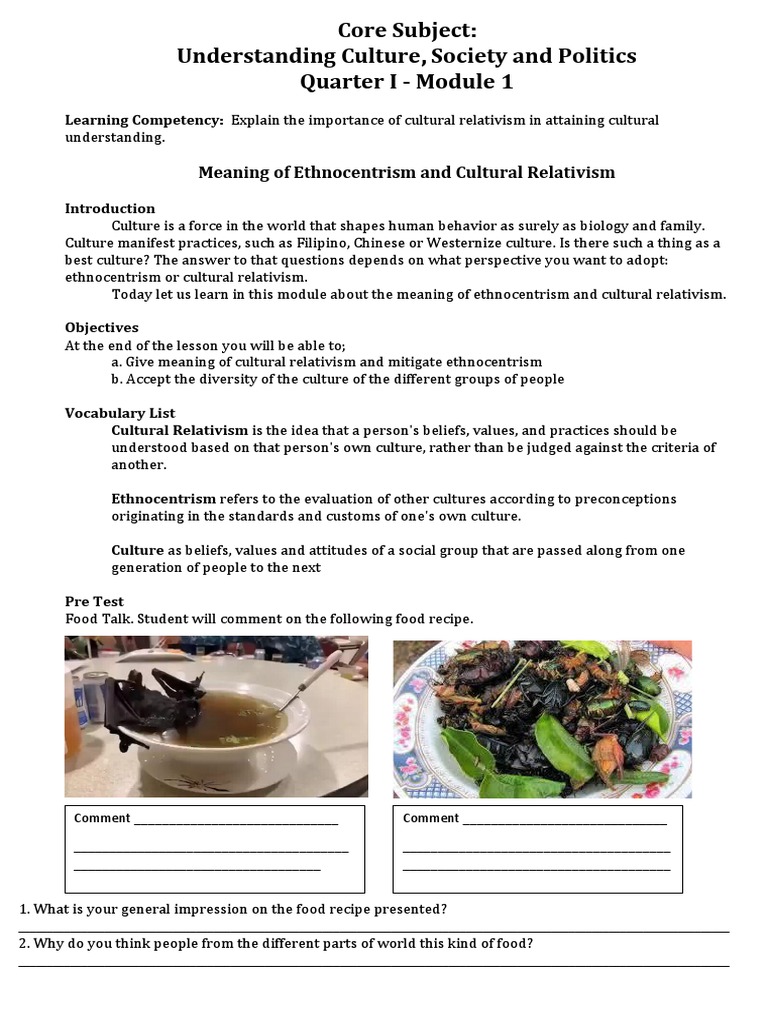In the realm of cultural studies, two concepts stand at the forefront: ethnocentrism and cultural relativism. Both of these ideologies serve to illuminate the complexities of human societies, yet they present distinct frameworks through which we interpret cultural phenomena. Understanding these concepts is paramount, particularly in a world increasingly interconnected by globalization and technological advancement.
At its core, ethnocentrism is the inclination to view one’s own culture as central and superior to others. This tendency can manifest in various ways, from overt discrimination to subtle biases that shape one’s worldview. Ethnocentric individuals often perceive their cultural norms and values as the standard by which other cultures are judged, which can lead to a myriad of misunderstandings and conflicts. For instance, consider the notion of beauty standards. Many individuals may regard their culture’s standards as definitive, dismissing other forms of expression due to their lack of familiarity.
Conversely, cultural relativism posits that one should understand and evaluate a culture based solely on its own context and values. This theoretical approach urges individuals to suspend their judgments and strive for comprehension rather than condemnation. By employing cultural relativism, one can appreciate the nuances within diverse societal frameworks. However, can this perspective ever be taken too far? Does the emphasis on understanding mean we turn a blind eye to harmful practices or injustices that clash with universally recognized human rights?
The juxtaposition of these two concepts raises fascinating inquiries. For one, how does ethnocentrism affect our global interactions today? As nations grapple with multiculturalism, the reluctance to appreciate and celebrate diversity can hinder diplomatic relations and collaborative efforts toward solutions. For instance, in climate discussions, ethnocentric viewpoints can obstruct meaningful action, leading some countries to prioritize their interests while ignoring the global implications of environmental degradation.
Moreover, let us ponder the challenge posed by cultural relativism: where do we draw the line when confronted with practices that may seem intolerable through a universal lens? A vivid example is the cultural sanctions against female genital mutilation present in some societies. While cultural relativism encourages understanding, does it not also complicate our stance on human rights? This quandary underscores the delicate balance required when navigating these ideological waters.
Possibly one of the most critical arenas where ethnocentrism and cultural relativism collide is in education. Curricula often reflect the prevailing cultural narratives of the dominant society, potentially alienating minority cultures. As educators, how do we create an inclusive environment that honors diverse cultures while avoiding the pitfalls of ethnocentrism? The challenge lies in constructing a pedagogical foundation that embraces multiple perspectives and fosters respect among students of varied backgrounds.
An infographic on ethnocentrism and cultural relativism could eloquently highlight these contrasts. Through visual elements like charts and graphs, one could illustrate the prevalence of ethnocentric views across different societies alongside statistics reflecting the impact of cultural relativism in promoting understanding and tolerance. This visual representation could provide clarity, making these abstract concepts more tangible and accessible to a broader audience.
While ethnocentrism can breed division, cultural relativism can cultivate empathy. However, one must also consider the limitations of cultural relativism. As societies evolve, the challenge of reconciling differing cultural practices becomes ever more pertinent. How can we foster a global conversation that is both sensitive to cultural contexts yet vigilant against practices that infringe upon fundamental human rights?
Ultimately, it is essential to recognize that both ethnocentrism and cultural relativism, while seemingly opposing, possess intrinsic value. Ethnocentrism can engender a sense of identity and belonging, whereas cultural relativism promotes openness and intercultural dialogue. The task at hand is not to vilify one perspective in favor of the other, but rather to cultivate an environment in which both can coexist. This harmonious coexistence can facilitate a deeper understanding of cultural dynamics, enriching our global society.
In conclusion, as individuals and communities navigate the complex interplay between ethnocentrism and cultural relativism, they must acknowledge the inherent challenges posed by both ideologies. By fostering a keen awareness of our biases and embracing cultural diversity, we can work together toward a more equitable world. As we confront pressing issues like climate change, the lessons drawn from understanding these cultural frameworks become ever more vital. By transcending ethnocentric barriers and adopting a culturally relativistic stance, we are not merely broadening our perspectives; we are also enriching our potential for collaboration in addressing global challenges.
